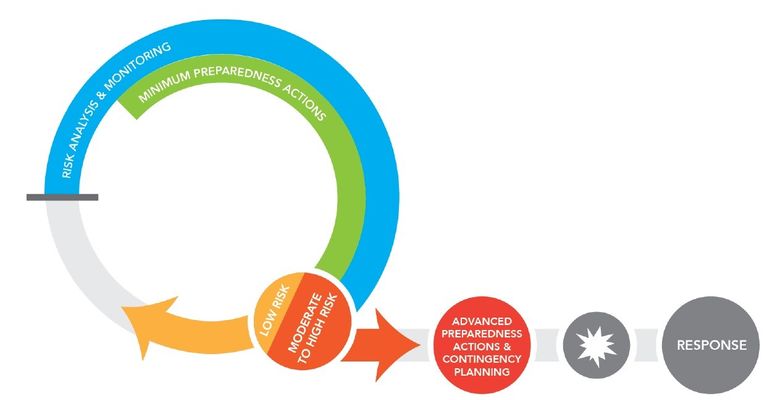Contribute to the multisector Emergency Preparedness Plan (ERP)
As per the IASC guideline, Emergency Preparedness Plan present two parts:
- In all context, Minimum Preparedness Actions should be implemented by relevant agencies. They include
- Risk monitoring and analysis
- Plan coordination arrangements in case of disaster
- Plan for Information management arrangement
- Preparations for joint needs assessment,
- Establishment of operational capacity to increase readiness
- Mitigate/prevent risk
- When in a certain context a particular risk becomes high, it should triggers Advanced Preparedness Actions. They include:
- Reaching out to national counterparts, local partners, communities to coordinate preparedness plans and assess response capacity;
- Deploying appropriate coordination, information management, needs assessments and response monitoring systems and developing a sourcing strategy for priority relief items;
- Organizing simulation exercises to increase readiness to respond;
- Contingency planning
Contingency plans are therefore established only when a certain risk becomes likely. for this specific risk, a contingency plan will include the following information:
- Situation & Risk analysis
- WASH response strategy: what would be the response logical framework analysis in case this risk occurs: objectives, results, activities, indicators
- Operational delivery: define what would be the geographical targeting, what would be the prefered aid delivery modality, what are the recommendation regarding using local markets etc.
- Coordination arrangement: agreed coordination structure, priority cluster to be activated, relationship with local government or military
- Operational support arrangement: arrangement regarding needs assessment, response monitoring, transport of material and team, security aspects
- Preparedness gaps and action: follow up on agencies preparedness actions
- Funding requirement: what would be the cost of the response, what would be the likely sources of funding, funds prepositioning
Form an ERP Task force
This step consists in identifying key WASH stakeholders interested and capable to be involved in the process and create a dedicated group of partners, representative but small enough to be efficient. Engage with other actors and local communities during the process when relevant.
Risks analysis and scenario building
ERP can be defined as a process to manage risk. Risk must be listed and prioritized based on their likelihood and planned impact on human life. Basic scenarios should be developed based on how an expected disaster or emergency will evolve and in doing so take into account what will be the impact on the humanitarian situation and the corresponding intervention.
Develop the emergency WASH response strategy
Based on the most likely risks identified and the scenario, propose a strategy to respond to the WASH needs of the affected population.
Assessing core capacities and gaps
To mitigate and respond to the risks and needs identified in the scenarios, an ideal level of capacity is needed from the WASH sector (NGOs, local authorities, local population etc.). The level of capacity of these stakeholders may not be sufficient, and capacity gaps are observed. Assess these capacities to identify gaps.
Develop the ERP plan
Capacities and capacity gaps were identified in the previous step. The ERP plan must propose an approach ,shared by most partners, on of how to decrease the gaps identified and strengthen the sector. Actions to be taken are grouped in two categories:
- Minimum Preparedness Actions (MPA): to be systematically implemented
- Advanced Preparedness Actions and contingency planning: to be implemented only when risk has become very likely
Monitor and evaluate the ERP plan
WASH coordination platforms monitor the implementation of preparedness actions by partners, advocate in case delays or gaps are observed and regularly update the ERP. After an emergency, the ERP must be reviewed or evaluated to understand what worked and what didn’t, and improve it.

Add Comment